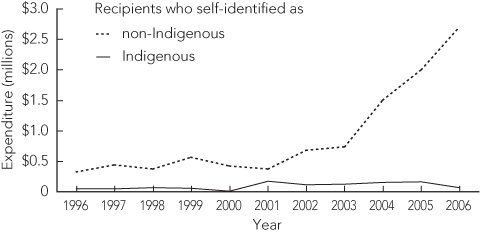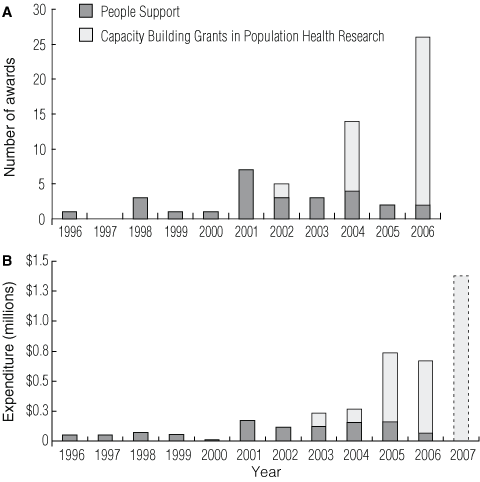As Australia’s leading agency for funding health research, the National Health and Medical Research Council (NHMRC) has the major responsibility for funding research to improve the health of Aboriginal and Torres Strait Islander people. In 2002, the NHMRC committed to spending at least 5% of its budget on Indigenous health research and endorsed The NHMRC Road Map: a strategic framework for improving Aboriginal and Torres Strait Islander health through research.1 The NHMRC Road Map emphasises the need to build research capacity in Indigenous health, by improving research practices and increasing the numbers of researchers, particularly those from Indigenous backgrounds.2,3
The NHMRC expends about a fifth of its annual research budget on Scholarships and Fellowships, known as People Support awards, that pay the salaries of researchers at different stages of their careers. The People Support awards are particularly important for building research capacity in historically underfunded areas, such as Indigenous health, because they offer an opportunity to increase the number and quality of researchers and develop the workforce for the future.4 People Support funds four main types of awards for researchers with increasing experience: Scholarships, Training Awards, Career Development Awards, and Career Awards.5
In addition to these established schemes, in 2002, NHMRC Capacity Building Grants in Population Health Research were introduced for a period of 5 years to build capacity in public health and health services research through support for early career researchers in a team environment. Within each research team, senior researchers, or lead applicants, are identified as mentors for junior team investigators.6
We used the NHMRC Research Management Information System to capture information about the distribution of People Support awards to advance Indigenous health research between 1996 and 2006. A keyword search was used to identify awards with the terms “Aborigines or Aboriginal”, “Torres Strait Islander”, “Indigenous” or “Koori” in either the title, lay summary, keywords, or fields of research. Among all applicants for NHMRC People Support, only those who were successful and commenced their award were included. The data included information on: grant identification number, applicant name, name and state of administering institution, project title, broad research area and fields of interest, type of award, and financial allocation per calendar year. These data were reconciled against those on the NHMRC website at http://www.nhmrc.gov.au/grants/dataset/_files/aboriginal.xls (as at July 2008); however, this was not possible for data on funding for people from Indigenous backgrounds.
From 1996 to 2006, 134 People Support awards were made to researchers studying Indigenous health (Box 1). Most awards were PhD scholarships, but over time there was an increasing number of more senior awards in Indigenous health. Most researchers studying Indigenous health identified public health as their broad research area (60%), with 20% nominating basic sciences, 10% clinical medicine and science, 9% health services research, and 1% preventive medicine and science. Among all NHMRC People Support recipients, the respective figures are 10% public health, 64% basic sciences, 23% clinical medicine and science, 2% health services research, and 1% preventive medicine and science.
The numbers of active awards and unadjusted expenditure from People Support for all recipients and for only those studying Indigenous health from 2001 to 2006 are shown in Box 2. Data before 2001 are not shown because changes to the NHMRC’s method of recording Fellowships in 2001 mean that funds for total People Support awards are not comparable before this date. These changes do not affect the data for Indigenous health awards alone, as no Fellowships in Indigenous health were awarded before 2003.
Box 3 shows the annual unadjusted People Support expenditure on Indigenous health research for scholars who self-identified as Indigenous compared with those who did not. The total expenditure on People Support awards for Indigenous health research increased from $376 023 in 1996 to $2.7 million in 2006; over the same period, expenditure on researchers from Indigenous backgrounds remained relatively unchanged, with $50 592 in 1996 and $64 038 in 2006. Thus, although the funds expended on People Support awards for Indigenous health research increased substantially during this period, there was no comparable increase in support for researchers from Indigenous backgrounds.
Box 4 compares People Support and Capacity Building Grants during the period 1996–2006 by (a) the number of new awards to Indigenous recipients and (b) by annual expenditure on scholars from Indigenous backgrounds. In 2006, there was a substantial increase in the number of new awards to Indigenous researchers through Capacity Building Grants; however, these funds only began to flow in 2007. Although beyond the period of analysis of this study, Box 4 shows the anticipated expenditure in 2007, to illustrate the likely substantial flow-on effects of the numbers of awards granted in 2006. During the period of the Capacity Building Grants (2002–2006), substantially more funding was granted to Indigenous researchers through the Capacity Building Grants program (36 positions) than through People Support (14 new awards).
The proportions of People Support funding allocated to Indigenous health research remained relatively stable from 1996 to 2002, despite a major injection of funds to the NHMRC following the Wills Review in 1998.7 However, after the policy change in 2002, there was a substantial increase in the proportion of funds allocated to Indigenous health research, rising from 1.4% of annual expenditure in 2001 to 2.9% in 2006. By 2006, 4.5% of active People Support awards were to people studying Indigenous health, albeit with most of these awards at the most junior level. This increase occurred without extensive implementation strategies by the NHMRC; the primary strategies were to lower the cut-off point for success and to advertise NHMRC’s commitment to increased funding.
There are a number of innovative international programs specifically targeting researchers from indigenous backgrounds that might inform future Australian programs. For example, New Zealand has made a commitment to establish a critical mass of Māori scholars by training 500 PhD scholars across all disciplines within 5 years. According to reports from the New Zealand Centre of Research Excellence, this is on target and progress has been greatly facilitated by the roll-out of a comprehensive mentoring program for all PhD students.8 In Canada, one of the Institutes of Health Research focuses on indigenous health, and an innovative training model similar to a travelling university has been developed by the Centre for Aboriginal Health Research to teach applied research skills to indigenous people in their communities.9,10 These programs are carefully targeted to address the needs of indigenous people in training for research; as with the Capacity Building Grants, they offer systematic mentoring approaches.
2 People Support awards — active awards, expenditure* and proportions allocated to Indigenous health research, 2001–2006
Received 11 April 2008, accepted 9 September 2008
- Sophia Leon de la Barra1,2
- Sally Redman2
- Sandra Eades3
- Carey Lonsdale4
- 1 University of Sydney, Sydney, NSW.
- 2 The Sax Institute, Sydney, NSW.
- 3 Baker IDI Heart and Diabetes Institute, Melbourne, VIC.
- 4 Australian Government Department of Health and Ageing, Canberra, ACT.
Sophia Leon de la Barra received a postgraduate stipend from the School of Public Health at the University of Sydney during this research.
The NHMRC reimbursed travel costs to Canberra for Sophia Leon de la Barra on two occasions. Sally Redman was a member of NHMRC’s Research Committee during the preparation of this manuscript. Sandra Eades was a member of the NHMRC Aboriginal and Torres Strait Islander Research Agenda Working Group and a co-author of the NHMRC Road Map. Carey Lonsdale was employed by the NHMRC from July 2005 to January 2008, during which one of her responsibilities was to advance the Aboriginal and Torres Strait Islander health research agenda.
- 1. National Health and Medical Research Council. Report of the 144th Session of the NHMRC. Item 10.6: NHMRC Indigenous representation and other issues. Canberra: NHMRC, Oct 2002: 15-20. http://www.nhmrc.gov.au/publications/reports/sess144.htm (accessed Mar 2007).
- 2. Aboriginal and Torres Strait Islander Research Agenda Working Group of the National Health and Medical Research Council. The NHMRC Road Map: a strategic framework for improving Aboriginal and Torres Strait Islander health through research. Canberra: Commonwealth of Australia, 2003. http://www.nhmrc.gov.au/publications/synopses/_files/r28.pdf (accessed Mar 2007).
- 3. Aboriginal and Torres Strait Islander Research Agenda Working Group of the National Health and Medical Research Council. Final report of community consultations on the NHMRC Road Map. Canberra: Commonwealth of Australia, 2003. http://www.nhmrc.gov.au/publications/synopses/_files/r27.pdf (accessed Mar 2007).
- 4. Anderson WP. Funding Australia’s health and medical research. Med J Aust 1997; 167: 608-609. <MJA full text>
- 5. National Health and Medical Research Council. Annual Report 2004. Appendix XVII — Health and medical research grants: people support. Canberra: NHMRC, 2005: 125-129. http://www.nhmrc.gov.au/publications/synopses/_files/nh55.pdf (accessed Oct 2008).
- 6. National Health and Medical Research Council. Program framework for the Capacity Building Grants in Population Health Research — Rounds 4 & 5. Canberra: NHMRC, 2006. http://www.nhmrc.gov.au/grants/apply/strategic/_files/cbgphr_framework.pdf (accessed Mar 2007).
- 7. Health and Medical Research Strategic Review Committee. The virtuous cycle: working together for health and medical research. Health and medical research strategic review discussion document. Canberra: Commonwealth of Australia, 1998. http://www.health.gov.au/internet/wcms/publishing.nsf/content/hmrsr.htm/$FILE/discussion_document.pdf (accessed Mar 2007; no longer available).
- 8. Centre of Research Excellence (CoRE). Proceedings of Hui Whakapiripiri; 2006 Aug 9–11; Wellington, New Zealand.
- 9. Elias B, O’Neil J. Building capacity in applied population health research. Winnipeg: Centre for Aboriginal Health Research, 2001. NHRDP Project No. 6607-1762-003. http://www.umanitoba.ca/centres/cahr/researchreports/Building%20Capacity%20in%20Applied%20Aboriginal%20Population%20Health.pdf (accessed Oct 2008).
- 10. Cooperative Research Centre for Aboriginal Health. Aboriginal health research capacity development strategy. Darwin: CRCAH, Mar 2006. http://www.crcah.org.au/downloads/CRCAH-Capacity-Development-Strategy-March-2006.pdf (accessed Oct 2008).







Abstract
Objective: To investigate National Health and Medical Research Council (NHMRC) support over the decade to 2006 for researchers studying Indigenous health and researchers who self-identified as Indigenous.
Design and setting: Review of data on all recipients of People Support awards and Capacity Building Grants in Population Health Research who were researching Indigenous health or who self-identified as Indigenous between 1996 and 2006.
Main outcome measures: Annual People Support and Capacity Building grants and expenditure, by broad research area, state or territory, administering institution, and Indigenous status (as self-identified by award recipients in their applications).
Results: Between 1996 and 2006, 134 People Support awards were made to researchers studying Indigenous health; of these, 27 (20%) were to researchers who self-identified as Aboriginal or Torres Strait Islander. In 2006, about 2.9% of the annual expenditure on all People Support funding was for Indigenous health research, representing a doubling in the proportion of funds since 2001. There was no increase in the number of self-identified Indigenous researchers funded under People Support, but Capacity Building Grants increased the number of people from Indigenous backgrounds supported by the NHMRC, with funds allocated to 36 Indigenous researchers from 2002 to 2006, compared with 14 funded by People Support during the same period.
Conclusions: Funding to support Indigenous health research through the People Support scheme has increased since the NHMRC adopted policy changes in 2002, but it has not reached the targeted expenditure of at least 5% of agency allocations. The Capacity Building Grants have been a more effective vehicle for funding researchers from Indigenous backgrounds.